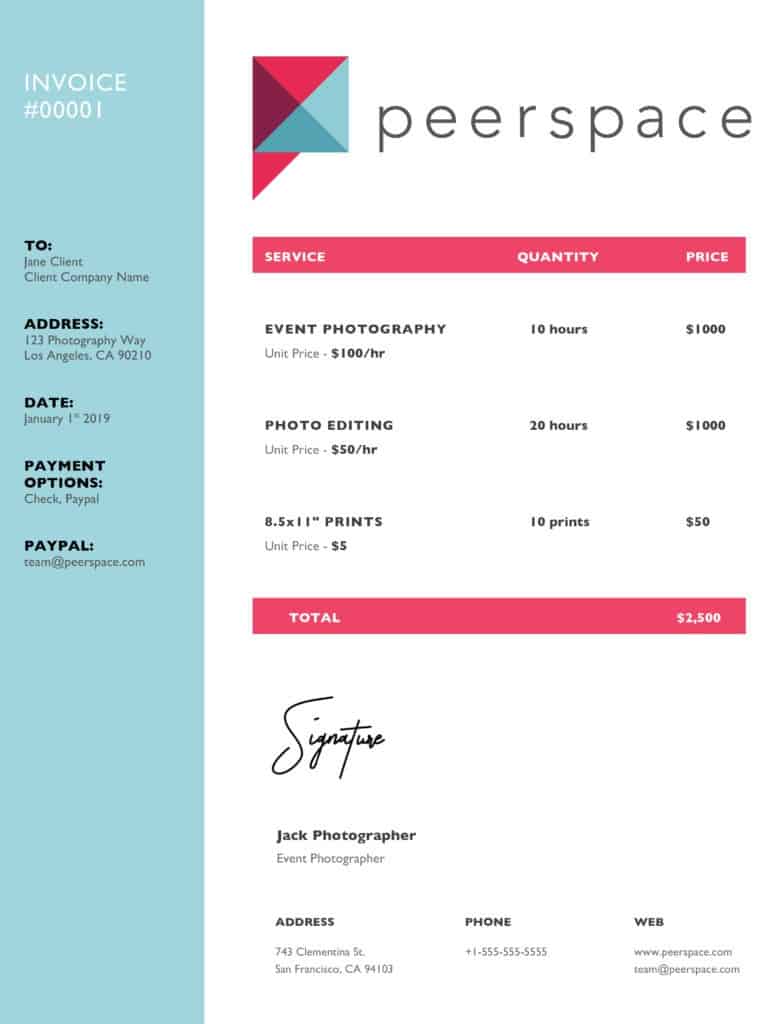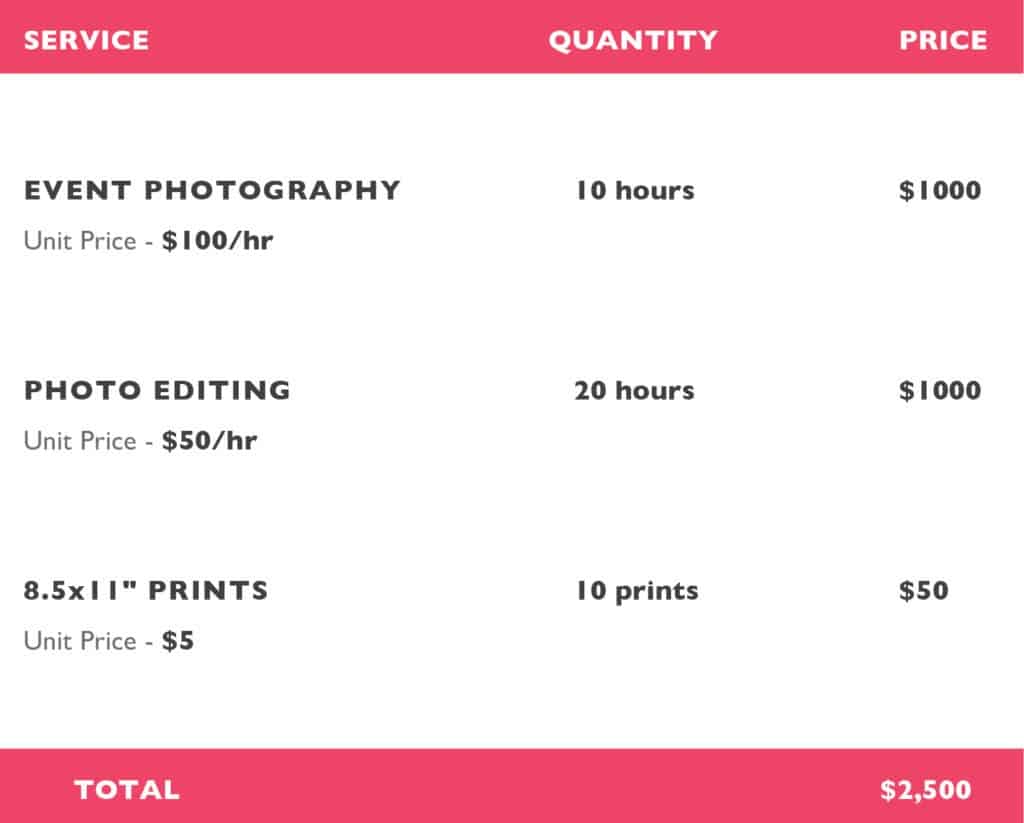
Source: Pixabay
So you’ve given some thought to how much you should charge for your photoshoot, and you’ve marketed your photography business. You’ve gotten your first client and crushed the shoot. Congratulations! But if you want to actually get paid, you’ll need to know how to send an invoice for your photography.
Why do I even need to invoice?
For one, most clients will expect an invoice, which serves as a record of their expense and acts as another way of verifying the agreed-upon amount that they owe for you services. For our purposes, it’s okay to think of it as a bill. They’re essentially the same thing, with a few minor context-dependent differences.
Furthermore, for you the invoice is a vital tool for keeping track of your business. It’s never too early to make a habit of good business practices, and as you grow you’ll find that staying organized and keeping good records will save you loads of time, especially as tax season approaches. And remember, as a professional photographer, time is money.
Another reason to invoice in a professional and timely manner is that it enhances your presentation of yourself as a skilled, experienced professional. When you’re detail-oriented and efficient in the business side of your photography practice, that tells current and potential clients that you’re a serious professional, not an amateur pursuing a hobby.
What information needs to be on an invoice?
At minimum, it’s good to include the following:
- Your contact information
- The client’s contact information
- An invoice number
- The date of the invoice
- The amount owed
- The service you have provided
- Any relevant information on how to pay
You might also include a due date (if applicable), any terms and conditions, or really any other information you deem relevant. To begin with, it’s totally fine to keep it simple. The most important thing is simply that the invoice needs to show how much the client owes and gives them the information needed to make payment.
To better illustrate what this might look like, we’ve whipped up a fictional Peerspace invoice to serve as a template. You can see all the information here:

A plain-Jane invoice is perfectly normal — you don’t have to have your invoice branded with your colors and a logo — but it can be a nice touch. Likewise, a lot of freelancers include a graphic of a digital signature like the sample on ours. These little touches just add an extra bit of flair to your business documents, further communicating to the world that you’re running a serious business. And when you’re in the business of creating beautiful things — as all photographers are — then bringing a little extra beauty to all aspects of your business works to your benefit.
Fee structure
There are three main methods of charging, usually called Time Plus Cost, Lump Sum, and Upset Limit billing. Presumably, by the time you invoice, you’ve already decided on all of this with the client, but we’ll do a quick review:
Time Plus Cost
You charge an hourly fee, plus a flat fee for any costs incurred (as such as if you need to rent equipment.)
Lump Sum
You charge one flat fee for the whole project, or you charge a series of flat fees for different tasks. You get paid the same amount, whether the job takes you a day or a week.
Upset Limit
You bill with a Time Plus Cost method, but only up to a set maximum amount. So, you might be charging $100 an hour with a maximum of 3 hours, for a total of $300. If the job takes you longer than that, you’d still only charge up to $300.
Our example invoice just lays it all out with a simple Time Plus Cost breakdown:

So, here we’re charging $100/hour to shoot an event, then $50/hour for photo editing. The client has also ordered 10 hardcopy prints, for which we’re charging a flat $50. Pretty straightforward, right?
Invoicing services and software
So far, we’ve been talking about making an invoice and sending it over to the client, who then pays by check, PayPal, bank transfer, or whatever other means you’ve worked out. That’s a good thing to understand, since it acquaints you with the moving parts of an invoice and how the process traditionally works.
However, an increasingly popular way of invoicing is to do it within a specialized app or from within accounting software you might already use. PicSpotr, for example, is a platform marketed towards photographers that handles invoicing and payments, among other things. When a client receives a PicSpotr invoice, they can pay it online via credit card the same way they’d buy anything else online. Most business management and accounting software includes the same sort of functionality, including options like Quickbooks and Wave.
PayPal also allows you to send invoices. It works the same way as other services: the client receives the invoice via e-mail and can pay it online securely via credit, debit, or with their own PayPal credit. That money is then transferred to you.
With services like these, you’re usually able to customize—at least to a limited degree—the look of the invoice with your own branding, though of course never to the same degree of making your own document from scratch. Two other major advantages to this approach are that you’ll end up with a centralized listing of all your invoices and incoming payments and that you’ll usually end up with the funds in your bank account more quickly than if you’d offered the option to pay by check.
Methods of payment
You’ll probably find that clients are pretty easy-going about the methods in which you ask them to pay. Generally the smaller the client, the more flexible they’ll be, while bigger corporate clients will have their own systems in place. Sometimes large organizations will want you to register as an approved vendor (with accompanying paperwork) and then invoice for their records. Bigger clients are also more likely to pay by bank transfer or ACH. In those scenarios you’d provide a bank account number and/or routing number, and they’ll transfer from their account to yours. As long as all the pertinent information is on your invoice, the nuts and bolts of how you get paid won’t be a problem. You’ll be all set.
The bottom line
Set yourself up for success! Implement the process that makes things easiest and simplest for you and your company. At the same time, don’t slack on this side of the business. Use invoices. Use contracts. Keep good records. Don’t rely on handshakes and verbal understandings, or you’re asking to get burned sooner or later. In the very beginning, doing this sort of clerical and accounting work can seem a little intimidating, but it quickly becomes an easy and routine part of your workflow. Most of all, if you want to turn a photography hobby into a real business, you have to behave like a real business. Forming good habits early will put you a mile ahead of the competition. Good luck! Now, go forth and get paid.
Find unique production spaces on Peerspace
Get together somewhere better
Book thousands of unique spaces directly from local hosts.
Explore SpacesShare your space and start earning
Join thousands of hosts renting their space for meetings, events, and photo shoots.
List Your Space






